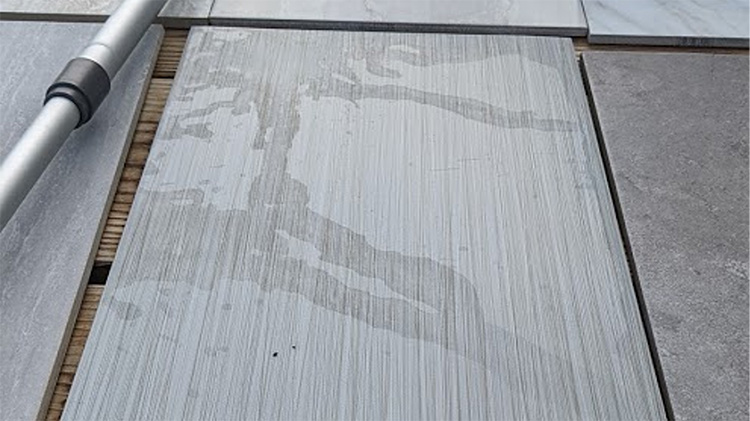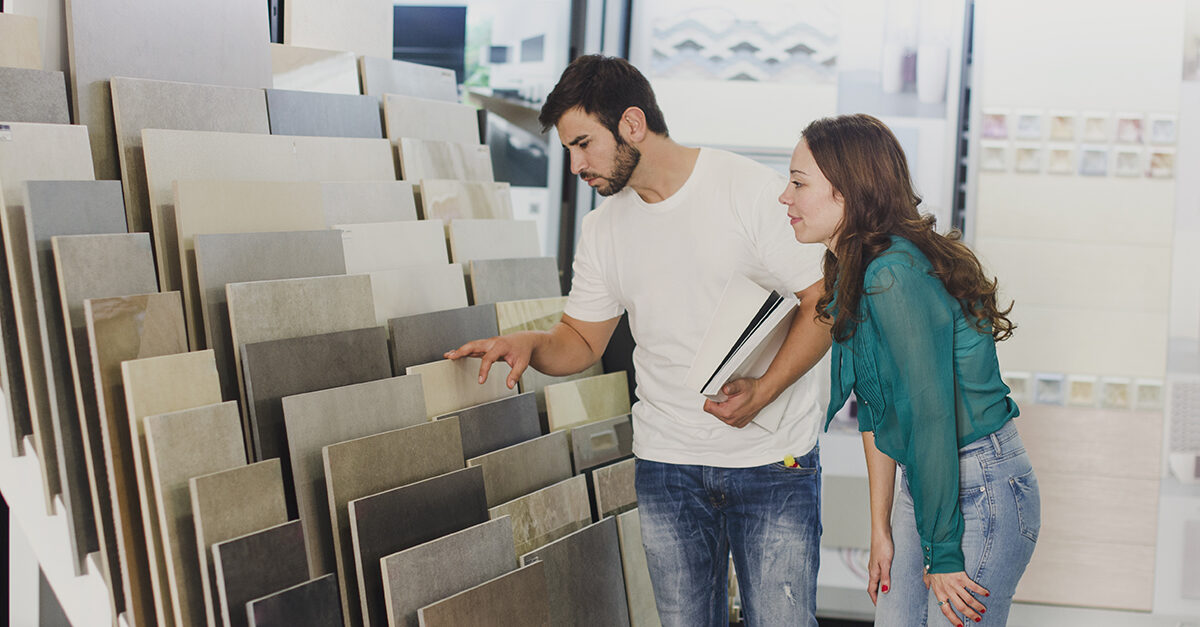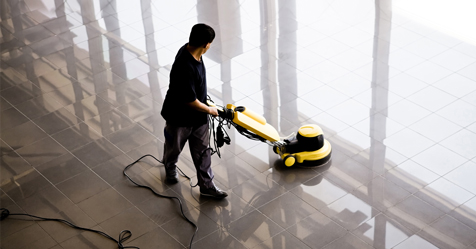Porcelain tile used to be a durable flooring material that was fairly straightforward to clean, but in the last few years, professional cleaners around the world have begun encountering problems cleaning newer porcelain products. When using high-pH presprays and cleaners, these tiles can dry with a splotchy pattern that is difficult to remove, and this can lead to dissatisfied customers and expensive restoration or replacement of the affected floor.
Industry experts Mike Pailliotet, founder of Mikey’s Board, and Mark Saiger, owner of Saiger’s Steam Clean, have seen the issue first-hand and are working diligently to come up with a solution for how to clean these popular flooring materials without damaging them.
Pailliotet first noticed the issue about three years ago when he was cleaning a newer floor using one of Saiger’s hard surface cleaning products. After cleaning and then rinsing the floor with water, the tile dried splotchy, but Pailliotet noted that the pattern of the marks was completely random, not correlating at all with his cleaning process or tools. This led him to believe it was a problem with either the cleaning solution or the floor. He was able to recreate the problem using a different high-pH cleaner, leaving just one possible culprit: the floor itself.
Pailliotet posted a video of that original floor on YouTube, and comments began trickling in from cleaners all over the world who have encountered the same phenomenon. Within the past six months, Pailliotet and Saiger have gotten an increasing number of calls, texts, and comments. Rarely a day goes by where they don’t hear about the problem.

Shown is the first instance of the porcelain splotching problem that Pailliotet experienced. Courtesy of Mark Saiger and Mike Pailliotet
Tile testing
On a mission to discover the cause of this porcelain tile cleaning issue, Pailliotet and Saiger began conducting their own tests. They went to flooring suppliers and big box stores and acquired a wide range of sample porcelain tiles. When these tiles are exposed to high-alkaline cleaners, whether liquid or powder, the same problem appears: a splotchy pattern that worsens and gets more difficult to remove with each cleaning.
In their tests, the problem didn’t always occur in the first cleaning of a sample tile, but subsequent cleanings resulted in splotching. “You could have been successful the first time—second time you’re not going to be as successful and you run into this splotchiness,” Saiger reports. Pailliotet found that even after buffing out the splotches, they reappear and worsen with each cleaning, becoming more difficult to remove. Pailliotet and Saiger also tried lower-pH cleaners, but eventually started to see the same effects with anything over a pH of 10.
Saiger admits they still don’t know exactly what the cause is, but “the suspect is wear and tear on the floor—homeowners cleaning it, environmental [factors] like lights.” He explains that porcelain should be very durable, but it seems newer porcelain products have a finish that degrades easily, resulting in this problem. “I call it a zombie issue,” Saiger says. “We come in with a little higher power, little more pH, a little more heat, and we expose what is going on there.”
Pailliotet points out that they can’t be sure what cleaning products might have been used or how those could affect the finish on the tiles. When a cleaning solution that has typically been safe and effective for porcelain floors suddenly causes this splotching problem, “we as the cleaner get blindsided, so we’re trying to get that word out,” Saiger explains. “It’s a panic mode; it really is. A skilled cleaner—even myself when I see this—I’m like, ‘Oh no.’”
Another unusual new product to be aware of is porous porcelain tiles, which are especially problematic because they absorb the cleaning solution, causing more splotchiness. Pailliotet had a customer who was oversold on how easy this type of floor would be to maintain but found that it soiled rapidly and was nearly impossible to keep clean. When he was called in for a professional cleaning, the prespray absorbed into the tiles and then wouldn’t respond to cleaning attempts. “I had to constantly reapply the cleaner, re-emulsify it, and go really slow with the turbo,” recalls Pailliotet.

This porous porcelain is becoming more common. Here we can see this almost pin-hole nature of it. Courtesy of Mark Saiger and Mike Pailliotet
Correcting the problem
Both in the field and in tests, Pailliotet has had some success removing the porcelain splotching by applying a neutral cleaner or acid rinse with water and then thoroughly buffing the floor; however, he and Saiger caution that, in the worst cases, it is not always possible to completely reverse the damage. “You can maybe get it to a level of satisfaction,” says Saiger. “It’s a little intense; it’s not a normal, easy thing for a carpet cleaner to do, but we tell [cleaners with this problem], start with buffing; start with neutral cleaner.”
To address more severe damage, MB Stone Care is developing an Italian porcelain restoration cream. Pailliotet explains this is a thick cream that polishes (or hones) the surface of the tile, but technicians will need to be careful because, if overworked, it can completely remove the glaze and even begin to remove the photograph under the glaze, which is what gives the tile its design. He suggests those without the proper experience and training leave this process to stone and tile restoration professionals.
What cleaners can do
Though Pailliotet and Saiger haven’t discovered the precise cause or a foolproof solution for porcelain tile splotching, they do have some tips for cleaners who encounter the issue in the field:
Identify the type and age of the floor—Just as you must be able to identify fibers to clean carpet, you must be able to distinguish between porcelain, ceramic, and stone in order to clean tile. Additionally, you need to determine the age of the floor since the splotching problem is a phenomenon of newer porcelain products. Pailliotet recommends asking your client when the floor was installed, and if you are unsure of its age, assume it is newer and proceed with caution.
Communicate with the client—Before you clean a floor that could be problematic, disclose to the client exactly what the risks are and your limitations to mitigate those risks. Pailliotet has created a free disclosure form cleaning technicians can use to discuss the risks with clients (downloadable at issa.com/porcelainform). As you educate your clients about this issue, encourage them to schedule regular cleanings before the floor is badly soiled so that gentler chemicals can be used with good results and there are fewer risks of damage to tile coatings.
Work in smaller areas—Pailliotet notes that the problem seems to be more likely to occur when a high-alkaline product is allowed to dry on the floor before it is rinsed. When cleaning porcelain floors, he recommends working in 100- to 200-square-foot sections and keeping the product wet until it is thoroughly rinsed away.
Pay extra attention to traffic lanes and pivot areas—Saiger has noted many cases where the splotching is being revealed in these areas, most likely due to foot traffic wearing down the factory coatings.
Use a neutral or lower-pH cleaner—Many newer floors use high-performance grout that is polymer- or epoxy-based, stain-resistant, and doesn’t require sealing. The benefit of these grouts is that high-alkaline cleaners might not be necessary to clean them, allowing professionals to use a gentler cleaning solution that may be less prone to splotching.
“These floors are very easy to clean; you can clean them with a modified carpet cleaning wand nowadays,” Pailliotet says. He recommends starting with a neutral cleaner and some dwell time to see if that can get the job done and working up from there if needed. This might take more time, but it is well worth it to avoid the unnecessary risk of ruining a client’s floor.
Saiger cautions there is no guarantee neutral or lower-pH cleaners won’t eventually cause the same issue, so be sure to follow their other recommendations on communicating with the client and working in small areas. Saiger says his team has been using a 9.5-pH solution and hasn’t run into trouble yet (His tests are ongoing.), but he has heard from cleaners in California who saw the splotching problem with a 9.9 pH solution. Since this is a new issue, Saiger notes there can be no promises about what will and won’t work at this point.
Decline the job—In the end, Pailliotet says if you aren’t confident in your abilities to clean porcelain floors or don’t have the equipment needed, like a 175 floor machine for buffing, you might consider declining porcelain tile cleaning jobs to avoid any liability for damaging the floors.

Testing found results like this, where allowing an alkaline cleaner to dry would cause dramatic marking. Courtesy of Mark Saiger and Mike Pailliotet
Final thoughts
This is an emerging problem in the industry, and even if you have not personally encountered it yet, you likely will in the future, especially if you work in areas of newer construction. Saiger and Pailliotet are committed to researching this issue and getting the word out, but they recommend professional cleaners do some of their own homework, too, especially as hard surface floors continue to grow in popularity.
“Spend time in tile stores and big box stores,” Pailliotet says. “See what they’re selling and what’s going to show up in the new developments in your area.”




